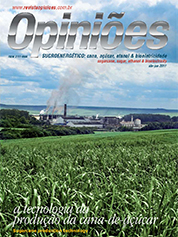Heloisa Lee Burnquist
Professor at Esalq-USP and Researcher at CEPEA
Op-AA-28
Mechanical harvesting: balance between costs and opportunities
The incorporation of technological innovations and more efficient management systems has demanded continuous reviews of cost models in the sugar and ethanol industry. Until the 70’s, sugarcane in Brazil was processed with the sole objective of producing sugar, after having gone through a diversification process in industrialization that made it possible to also use sugars for the production of ethanol.
In the course of the past decade, one could observe the development of a new paradigm for sugarcane, based on the “integral” and efficient use not only of its sugars in the production of various products, such as fuels (ethanol and others), chemical products, green plastic (PET), but also by making use of biomass (bagasse and straw) for the production of thermal energy and electricity. In this same period, a wave of transformations resulted in the implementation of mechanical harvesting.
In light of the probable elimination of sugarcane burning in fields, beginning in 2014, as set forth in the Cooperation Protocol on Sustainable Development of the Sugarcane Industry in the State of São Paulo, the introduction of the mechanical harvesting of sugarcane went from a possibility to become a concrete need.
After a short period, however, what initially seemed to be a major challenge, mainly with respect to the use of biomass and better management of the most important cost factor in sugarcane production, which is the process of cutting, loading and transporting, opened a range of possibilities.
Under pressure because of the speed at which sugarcane products are consumed, particularly ethanol as a carburant, producers seek to find a solution for a problem that is not new – the need to rapidly expand production to meet demand –, which, however, takes place in a different context that is more competitive, requires not only successively breaking production records in each harvest season, but also the capacity to achieve maximum returns on each additionally processed ton.
In this scenario, mechanization has been presented as an opportunity, allowing not only to increase production processing speed, but also the possibility to increment the volume of biomass supplied to the mills, rather than to burn it in the field. It was soon noticed that the requirements for a successful transition from manual to mechanical harvesting were not limited by the capacity to heavily invest in the acquisition of the equipment.
One must know how to operate mechanical harvesting. To that end, paraphrasing Ripoli, “there is no cake recipe”. The sugar and ethanol industry already has sufficient knowledge to use mechanical harvesting as a well consolidated process from a technical point of view.
However, discussions are still ongoing as to the possibility of increasing economic efficiency, reducing the time to pay the initial investment. The better use of residues, mainly by adding straw as complementary material to bagasse for the generation of bioenergy in the mills, stands out as the most immediate alternative.
For the mills, apart from generating a new source of income, co-generated energy may represent an opportunity to refurbish industrial units, with investments in new machinery and more modern and efficient equipment. Analyses performed show that approximately 50% of the generated straw can be taken from the field without adversely affecting agricultural activities or the environment.
In addition, they show that the use of straw as a source of energy is bound to result in significant energy gains for the industrialization of sugarcane. However, when transporting straw to the mills – either together with the sugarcane or separately in the form of bales – must be carefully planned.
This increase takes place for several reasons. When straw is transported to the mill together with sugarcane, the load density diminishes, increasing the transportation cost per ton of sugarcane. Furthermore, upon arriving at the mill, the straw must be separated from the sugarcane and needs to be dry-cleaned, which means performing operations that increase costs.
An option is to bale the straw, however this alternative involves aggregating other operations that end up burdening the system, and one should also notice that the baling equipment is as yet not deemed fully efficient, whereas the earth that comes along with the bales constitutes an important restriction.
Transporting cane together with straw also translates into costs, because the straw competes for space with sugarcane. In addition, it may interfere in industrial productivity and reduce the volume of sugar and ethanol that can be produced.
So, there is room for gains in efficiently managing the supply chain. One of the main challenges to be overcome is to efficiently solve the logistics of transferring the product from one operation to the next. As the product is processed along this chain, costs increase, making logistics efficiency a strategic issue, since it identifies cost effective operations that warrant the end product’s quality.
This has been the focal point in research, laying out scenarios to simulate results to be selected. Once this challenge is overcome, however, the Brazilian sugar and ethanol industry will also be prepared to supply low cost raw material, essential to render cellulosic ethanol – second generation ethanol –, projects feasible.




